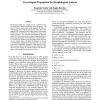Free Online Productivity Tools
i2Speak
i2Symbol
i2OCR
iTex2Img
iWeb2Print
iWeb2Shot
i2Type
iPdf2Split
iPdf2Merge
i2Bopomofo
i2Arabic
i2Style
i2Image
i2PDF
iLatex2Rtf
Sci2ools
AAAI
2008
2008
Cross-lingual Propagation for Morphological Analysis
Multilingual parallel text corpora provide a powerful means for propagating linguistic knowledge across languages. We present a model which jointly learns linguistic structure for each language while inducing links between them. Our model supports fully symmetrical knowledge transfer, utilizing any combination of supervised and unsupervised data across language barriers. The proposed non-parametric Bayesian model effectively combines cross-lingual alignment with target language predictions. This architecture is a potent alternative to projection methods which decompose these decisions into two separate stages. We apply this approach to the task of morphological segmentation, where the goal is to separate a word into its individual morphemes. When tested on a parallel corpus of Hebrew and Arabic, our joint bilingual model effectively incorporates all available evidence from both languages, yielding significant performance gains.
| Added | 02 Oct 2010 |
| Updated | 02 Oct 2010 |
| Type | Conference |
| Year | 2008 |
| Where | AAAI |
| Authors | Benjamin Snyder, Regina Barzilay |
Comments (0)

